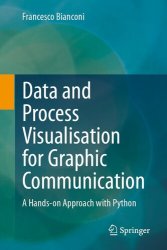 Название: Data and Process Visualisation for Graphic Communication: A Hands-on Approach with Python
Название: Data and Process Visualisation for Graphic Communication: A Hands-on Approach with PythonАвтор: Francesco Bianconi
Издательство: Springer
Год: 2024
Страниц: 242
Язык: английский
Формат: pdf (true)
Размер: 20.1 MB
This book guides the reader through the process of graphic communication with a particular focus on representing data and processes. It considers a variety of common graphic communication scenarios among those that arise most frequently in practical applications.
Graphic communication is a form of visual communication that employs images and graphics to convey information, ideas, and messages. It plays a fundamental role in several aspects of our personal and professional lives including education and learning, science and research, brainstorming, and decision-making as well as marketing and branding.
This volume aims at guiding the reader through the process of graphic communication with particular focus on representing data and processes. It considers a variety of common graphic communication scenarios among those that arise most frequently in practical applications, e.g., representing magnitudes, proportions, relations, groups, geographical data, timelines, etc.
The book is organized in two parts: representing data (Part I) and representing processes (Part II). The first part deals with the graphical representation of data. It starts with an introductory chapter on the types of variables, then guides the reader through the most common data visualization scenarios – i.e.: representing magnitudes, proportions, one variable as a function of the other, groups, relations, bivariate, trivariate and geospatial data. The second part covers various tools for the visual representation of processes; these include timelines, flow-charts, Gantt charts and PERT diagrams. In addition, the book also features four appendices which cover cross-chapter topics: mathematics and statistics review, Matplotlib primer, color representation and usage, and representation of geospatial data.
In both parts each graphic communication task is considered independently in a separate chapter which contains:
• An introduction and analysis of the graphic communication task with particular emphasis on the theoretical aspects such as the number and type of the variables involved, the distinction between dimensions and measures, etc.
• A proposal of one or more visual communication tools for tackling the task, for instance bar charts, pie charts, scatter plots, Gantt charts, and others • Provision, for each tool, of one or more practical examples based on real data and the corresponding implementation in Python
• Discussion of the technical details of the proposed implementation
At the time of writing Python is consistently ranked as the most popular programming language in the world. There are a number of reasons why it is so widely liked and appreciated. Chief among them are its ease of use, its flexibility, and the presence of an active and supportive community. The latter, in particular, is what makes it possible to have tailored packages for nearly any kind of application in the most disparate areas.
It is not uncommon to have a variety of Python packages for approaching the same task, in which case the programmer will have to make a choice among the options available. Graphic communication is no exception. As for data visualization, there are already a number of packages available: Bokeh, HoloViz, Matplotlib, Plotly and Seaborn are just some examples. In writing this book we therefore had to made a choice about which package(s) to consider for the examples presented herein. We initially decided to narrow the choice down to free tools only; consequently, paid services such as PlotAPI are not discussed in this book. Then, for each type of chart presented in the book, we proposed the implementation that we thought was the most clear and concise. When there were substantially equivalent solutions, we favored Matplotlib, both due to personal experience and the historical importance of this library.
Our choice for the code was to keep all the Scripts self-contained and hence separate from one another. The main advantage is that the reader can look at and execute each script independently, without having to browse back and forth through the book to find the missing parts. The downside, of course, is that there is some code repetition: some parts (e.g., data loading and cleansing) are just copied and pasted from one script to another. In a limited number of cases, when the difference between two scripts was minor (by the order of two/three lines of code), we used Code fragments to avoid excessive redundancy.
Note that Scripts are self-contained, executable Python scripts, whereas Code fragments are snippets of code that cannot be executed separately: these are typically used to show tweaks and changes to other scripts.
Aimed at junior and senior undergraduate students in various technical, scientific, and economic fields, this book can also be a valuable aid for researchers and practitioners in data science, marketing, entertainment, media, and other fields.
Prerequisites:
Preliminary knowledge of Python at an intermediate level is not strictly necessary but highly recommended. It is assumed, in particular, that the reader be familiar with some common Python libraries such as NumPy and Pandas. But those who start from scratch should not panic, as there are plenty of good resources out there to help them out. Matthes’ crash course is an excellent introduction to the language; Ramalho’s Fluent Python is a classic for those who want to take their skills to the next level. Martelli et al.’s Python in a Nutshell is also an amazingly deep yet accessible desktop reference. For those who want to familiarize themselves with Pandas and NumPy, McKinney’s Python for Data Analysis is our recommendation. Among the countless online resources we recommend Real Python, a platform featuring tutorials, news, articles, and code examples for Python developers of all levels.
Скачать Data and Process Visualisation for Graphic Communication: A Hands-on Approach with Python